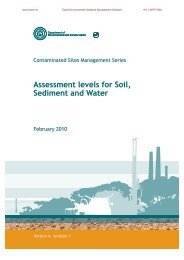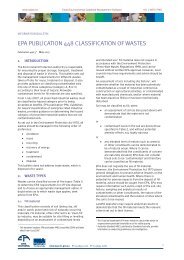Soil Generic Assessment Criteria for Human Health Risk ... - ESdat
Soil Generic Assessment Criteria for Human Health Risk ... - ESdat
Soil Generic Assessment Criteria for Human Health Risk ... - ESdat
Create successful ePaper yourself
Turn your PDF publications into a flip-book with our unique Google optimized e-Paper software.
www.esdat.net Esdat Environmental Database Management Software +61 2 8875 7948<br />
Dichloromethane CAS Number: 75-09-2<br />
Assessor A: Nick Brown, Grontmij Assessor B Catherine Helm, WD Final Review:<br />
Panel/SF<br />
Environmental<br />
Date 26/05/2009 Date 01-Jun-09 Date 28/08/2009<br />
TDI inhal Recommended TDIinhal Units<br />
134.3 ug.kg-1.d-1<br />
Justification<br />
Derived from WHO weekly average. WHO based on human study, most conservative value.<br />
Organisation Last Updated Date Web Checked <strong>Health</strong> criteria type Value Initial Units CLEA units ug.kg-1.d-1 Confidence rating Basis Value Units UF UF description<br />
International Programme on Chemical Safety<br />
(IPCS)<br />
Joint Expert Committee on Food Additives<br />
(JECFA)<br />
WHO Air Quality guidelines <strong>for</strong> Europe http://www.euro.who.int/air/activities/20050<br />
222_2<br />
http://www.who.int/ipcs/en/ 01/04/2009 As WHO As WHO As WHO As WHO As WHO As WHO As WHO As WHO As WHO As WHO<br />
http://who.int/ipcs/food/jecfa/en/ 02/04/2009 As WHO As WHO As WHO As WHO As WHO As WHO As WHO As WHO As WHO As WHO<br />
02/04/2009 Air Quality Guideline 3 (0.47 - weekly average) mg/m3 857 (134.3) Predicted to cause 1%<br />
increase in COHb<br />
NA<br />
NA<br />
Dutch National Institute <strong>for</strong> Public <strong>Health</strong> and http://www.rivm.nl/en/ Published 2001 02/04/2009 TCA 3000 ug/m3 857 WHO value adopted NA NA<br />
the Environment (RIVM) Maximum<br />
Permissible <strong>Risk</strong> (MPR) levels<br />
US Agency <strong>for</strong> Toxic Substances and Disease<br />
Registry (ATSDR) Toxicological Profiles and<br />
Minimal <strong>Risk</strong> levels<br />
http://www.atsdr.cdc.gov/ 05/05/2009 MRL 0.3 (1.05) ppm<br />
(mg/m3)<br />
300 NOAEL 30 x 3 interspecies and x<br />
10 intraspecies<br />
ATSDR 2 http://www.atsdr.cdc.gov/ 05/05/2009<br />
Maximum<br />
concentration<br />
associated with acute<br />
exposure and<br />
irreversible harm<br />
750 ppm<br />
ID oral Recommended IDoral Units<br />
Justification<br />
N/A<br />
ug.kg-1.d-1<br />
<strong>Human</strong> studies are considered generally inadequate to demonstrate whether or not DCM is carcinogenic, however, carcinogenicity has been demonstrated in mice and<br />
to a lesser extent in female rats. IRIS provides the carcinogenic Classification —B2; probable human carcinogen. IARC classified dichloromethane as possibly<br />
carcinogenic to humans (Group 2B), based on inadequate evidence <strong>for</strong> the carcinogenicity of dichloromethane in humans and sufficient evidence <strong>for</strong> the<br />
carcinogenicity of dichloromethane in experimental animals. <strong>Health</strong> Canada classified dichloromethane as "probably carcinogenic to humans" (Group II) and has<br />
generated PBEK modified TD05 values (5% incidence of tumours). IRIS has also quantified carcinogenic risk by predicting concentrations equivalent to increased cancer<br />
risk of E-5. In relation to the tendency <strong>for</strong> tumor development in mice through exposure to DCM by inhalation, TERA comment that; "there are clear species<br />
differences in the putatively carcinogenic pathway of metabolism of dichloromethane which are consistent with the hypothesis that humans are likely to be less<br />
sensitive than some species of experimental animals in this regard". RIVM determined that dichloromethane is not considered to be genotoxic to humans, and<br />
there<strong>for</strong>e, derived risk values based on a threshold approach. Threshold based HCVs are also provided by ATSDR and WHO.<br />
In view of the uncertainty remaining in relation to the actual carcinogenicity of DCM to humans and uncertainty relating to the methods of quantification of nonthreshold<br />
risk, particularly in view of the guidance provided within SR2, the selection of conservative TDIs is considered more appropriate at this stage than the<br />
derivation Index Doses.<br />
Organisation Web Link Last Updated Date Web Checked Non threshold<br />
effects<br />
USEPA Integrated <strong>Risk</strong> In<strong>for</strong>mation System http://epa.gov/iris/ 02/04/2009<br />
(IRIS)<br />
Basis<br />
<strong>Health</strong> criteria<br />
type<br />
Carcinogenic risk<br />
level of E-5<br />
Value<br />
Units<br />
Confidence rating<br />
50 ug/l 1.42 Extrapolation Method<br />
— Linearized<br />
multistage procedure,<br />
extra risk<br />
Basis<br />
Yes<br />
Toxicology Data Network (Toxnet) http://toxnet.nlm.nih.gov/ 02/04/2009 Yes See IRIS data See IRIS data See IRIS data See IRIS data See IRIS data See IRIS data<br />
Page 3 of 6 EIC Pro<strong>for</strong>ma dichloromethane.xls 28/08/2009








